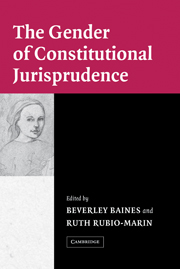Book contents
- Frontmatter
- Contents
- List of Contributors
- Acknowledgments
- The Gender of Constitutional Jurisprudence
- Introduction: Toward a Feminist Constitutional Agenda
- 1 Speaking into a Silence: Embedded Constitutionalism, the Australian Constitution, and the Rights of Women
- 2 Using the Canadian Charter of Rights and Freedoms to Constitute Women
- 3 Emancipatory Equality: Gender Jurisprudence under the Colombian Constitution
- 4 Gender Equality and International Human Rights in Costa Rican Constitutional Jurisprudence
- 5 Constituting Women: The French Ways
- 6 Gender in the German Constitution
- 7 India, Sex Equality, and Constitutional Law
- 8 Constitutional Transformation, Gender Equality, and Religious/National Conflict in Israel: Tentative Progress through the Obstacle Course
- 9 “No Nation Can Be Free When One Half of It Is Enslaved”: Constitutional Equality for Women in South Africa
- 10 Engendering the Constitution: The Spanish Experience
- 11 Gender Equality from a Constitutional Perspective: The Case of Turkey
- 12 Gender and the United States Constitution: Equal Protection, Privacy, and Federalism
- Index
- References
3 - Emancipatory Equality: Gender Jurisprudence under the Colombian Constitution
Published online by Cambridge University Press: 14 January 2010
- Frontmatter
- Contents
- List of Contributors
- Acknowledgments
- The Gender of Constitutional Jurisprudence
- Introduction: Toward a Feminist Constitutional Agenda
- 1 Speaking into a Silence: Embedded Constitutionalism, the Australian Constitution, and the Rights of Women
- 2 Using the Canadian Charter of Rights and Freedoms to Constitute Women
- 3 Emancipatory Equality: Gender Jurisprudence under the Colombian Constitution
- 4 Gender Equality and International Human Rights in Costa Rican Constitutional Jurisprudence
- 5 Constituting Women: The French Ways
- 6 Gender in the German Constitution
- 7 India, Sex Equality, and Constitutional Law
- 8 Constitutional Transformation, Gender Equality, and Religious/National Conflict in Israel: Tentative Progress through the Obstacle Course
- 9 “No Nation Can Be Free When One Half of It Is Enslaved”: Constitutional Equality for Women in South Africa
- 10 Engendering the Constitution: The Spanish Experience
- 11 Gender Equality from a Constitutional Perspective: The Case of Turkey
- 12 Gender and the United States Constitution: Equal Protection, Privacy, and Federalism
- Index
- References
Summary
After decades of extreme violence, many Colombians eagerly embraced the 1991 Colombian Constitution, some hailing it as a peace treaty. It was drafted and adopted by a specially elected constituent assembly approved in response to a student campaign that rallied support for constitutional reform under the slogan, “We can still save Colombia.” Admittedly, the new Constitution has fallen far short of the bold expectations of those who envisioned it as a “peace treaty” for a country that is still marked by seemingly unfathomable levels of violence. But the 1991 constitutional assembly presented an opportunity for a broad spectrum of the diverse society to unite around a new “social contract,” replacing the country's 1886 Constitution (then Latin America's oldest) with a modern document.
Despite the broadly proclaimed representativeness of the 1991 constituent assembly, women were vastly underrepresented — only four of the seventy-four members were women. But women and organizations advocating their causes were active outside the assembly as well. They participated in the official worktables organized, regionally and by sector, to collect citizen proposals for constitutional change. As a result of advocacy and lobbying activities, they obtained support for much of their agenda from both men and women within the assembly. In contrast to the 1886 Constitution, which did not even include an express equality provision, the 1991 Constitution includes broad tri-generational civil and political, social, and collective rights, including not only provisions specifically addressing gender equality but also several other gender-related protections.
- Type
- Chapter
- Information
- The Gender of Constitutional Jurisprudence , pp. 75 - 98Publisher: Cambridge University PressPrint publication year: 2004

